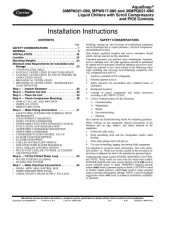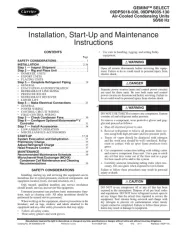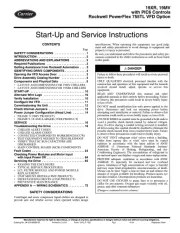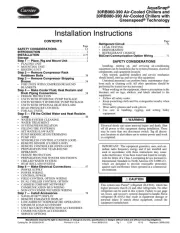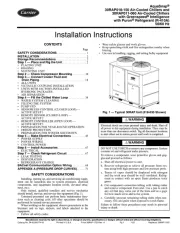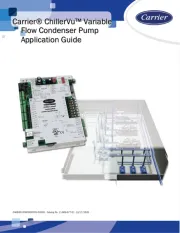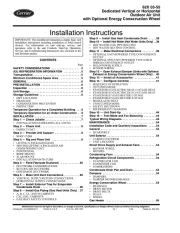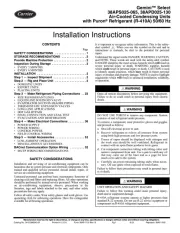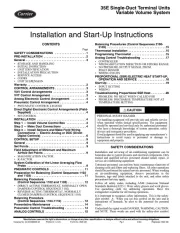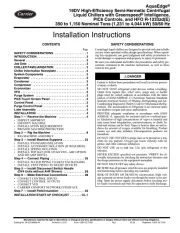
Manufacturer reserves the right to discontinue, or change at any time, specifications or designs without notice and without incurring obligations.
Catalog No. 04-53190090-01 Printed in U.S.A. Form 19DV-CLT-6SI Pg 1 10-22 Replaces: 19DV-CLT-5SI
Installation Instructions
CONTENTS
Page
SAFETY CONSIDERATIONS . . . . . . . . . . . . . . . . . . . 1
INTRODUCTION . . . . . . . . . . . . . . . . . . . . . . . . . . . . . . 3
General . . . . . . . . . . . . . . . . . . . . . . . . . . . . . . . . . . . . . 3
Job Data . . . . . . . . . . . . . . . . . . . . . . . . . . . . . . . . . . . . 3
CHILLER FAMILIARIZATION . . . . . . . . . . . . . . . . . . . 3
Chiller Information Nameplate . . . . . . . . . . . . . . . . . . 3
System Components . . . . . . . . . . . . . . . . . . . . . . . . . 3
Evaporator . . . . . . . . . . . . . . . . . . . . . . . . . . . . . . . . . . 3
Condenser . . . . . . . . . . . . . . . . . . . . . . . . . . . . . . . . . . 3
Compressor . . . . . . . . . . . . . . . . . . . . . . . . . . . . . . . . . 3
Economizer . . . . . . . . . . . . . . . . . . . . . . . . . . . . . . . . . 3
VFD . . . . . . . . . . . . . . . . . . . . . . . . . . . . . . . . . . . . . . . . 3
Purge System . . . . . . . . . . . . . . . . . . . . . . . . . . . . . . . 3
PIC6 Touch Screen Panel . . . . . . . . . . . . . . . . . . . . . . 3
Control Panel . . . . . . . . . . . . . . . . . . . . . . . . . . . . . . . . 3
Purge Control Panel . . . . . . . . . . . . . . . . . . . . . . . . . . 3
Lube Assembly . . . . . . . . . . . . . . . . . . . . . . . . . . . . . . 4
INSTALLATION . . . . . . . . . . . . . . . . . . . . . . . . . . . . . . 4
Step 1 — Receive the Machine . . . . . . . . . . . . . . . . . 4
• INSPECT SHIPMENT
• IDENTIFY MACHINE
• INSTALLATION REQUIREMENTS
• PROVIDE MACHINE PROTECTION
Step 2 — Rig the Machine . . . . . . . . . . . . . . . . . . . . . 8
• RIG MACHINE ASSEMBLY
Step 3 — Install Machine Supports . . . . . . . . . . . . . 23
• INSTALL STANDARD ISOLATION
• INSTALL ACCESSORY ISOLATION (IF REQUIRED)
• INSTALL SPRING ISOLATION
• INSTALL TOP HAT (FOR 32VSH VFD - AHF OPTION
AND 680 AMP DRIVE).
Step 4 — Connect Piping . . . . . . . . . . . . . . . . . . . . . 25
• INSTALL WATER PIPING TO HEAT EXCHANGERS
• INSTALL VENT PIPING TO RELIEF DEVICES
Step 5 — Install Disconnect Switch Handle
(DV4 Units without AHF Shown) . . . . . . . . . . . . . 28
Step 6 — Make Electrical Connections . . . . . . . . . . 28
• CONNECT CONTROL INPUTS
• CONNECT CONTROL OUTPUTS
• CONNECT VFD
• CARRIER COMFORT NETWORK INTERFACE
Step 7 — Install Field Insulation . . . . . . . . . . . . . . . 40
INSTALLATION START-UP CHECKLIST . . . . . . . CL-1
SAFETY CONSIDERATIONS
Centrifugal liquid chillers are designed to provide safe and reliable
service when operated within design specifications. When operat-
ing this equipment, use good judgment and safety precautions to
avoid damage to equipment and property or injury to personnel.
Be sure you understand and follow the procedures and safety pre-
cautions contained in the machine instructions, as well as those
listed in this guide.
DANGER
Failure to follow these procedures will result in severe person-
al injury or death.
DO NOT VENT refrigerant relief devices within a building.
Outlet from rupture disc, relief valve, purge unit, or fusible
plugs must be vented outdoors in accordance with the latest
edition of ANSI/ASHRAE 15 (American National Standards
Institute/American Society of Heating, Refrigerating and Air-
Conditioning Engineers) (Safety Code for Mechanical Refrig-
eration). The accumulation of refrigerant in an enclosed space
can displace oxygen and cause asphyxiation.
PROVIDE adequate ventilation in accordance with ANSI/
ASHRAE 15, especially for enclosed and low overhead spac-
es. Inhalation of high concentrations of vapor is harmful and
may cause heart irregularities, unconsciousness, or death. In-
tentional misuse can be fatal. Vapor is heavier than air and re-
duces the amount of oxygen available for breathing. Product
causes eye and skin irritation. Decomposition products are
hazardous.
DO NOT USE OXYGEN to purge lines or to pressurize a ma-
chine for any purpose. Oxygen gas reacts violently with oil,
grease, and other common substances.
DO NOT USE air to leak test. Use only refrigerant or dry
nitrogen.
NEVER EXCEED specified test pressures. VERIFY the al-
lowable test pressure by checking the instruction literature and
the design pressures on the equipment nameplate.
DO NOT VALVE OFF any safety device.
BE SURE that all pressure relief devices are properly installed
and functioning before operating any machine.
RISK OF INJURY OR DEATH by electrocution. High volt-
age is present on motor leads even though the motor is not run-
ning. Open the power supply disconnect before touching mo-
tor leads or terminals and wait for capacitors to fully discharge.
AquaEdge
®
19DV High-Efficiency Semi-Hermetic Centrifugal
Liquid Chillers with Greenspeed
®
Intelligence,
PIC6 Controls, and HFO R-1233zd(E)
350 to 1,150 Nominal Tons (1,231 to 4,044 kW) 50/60 Hz

